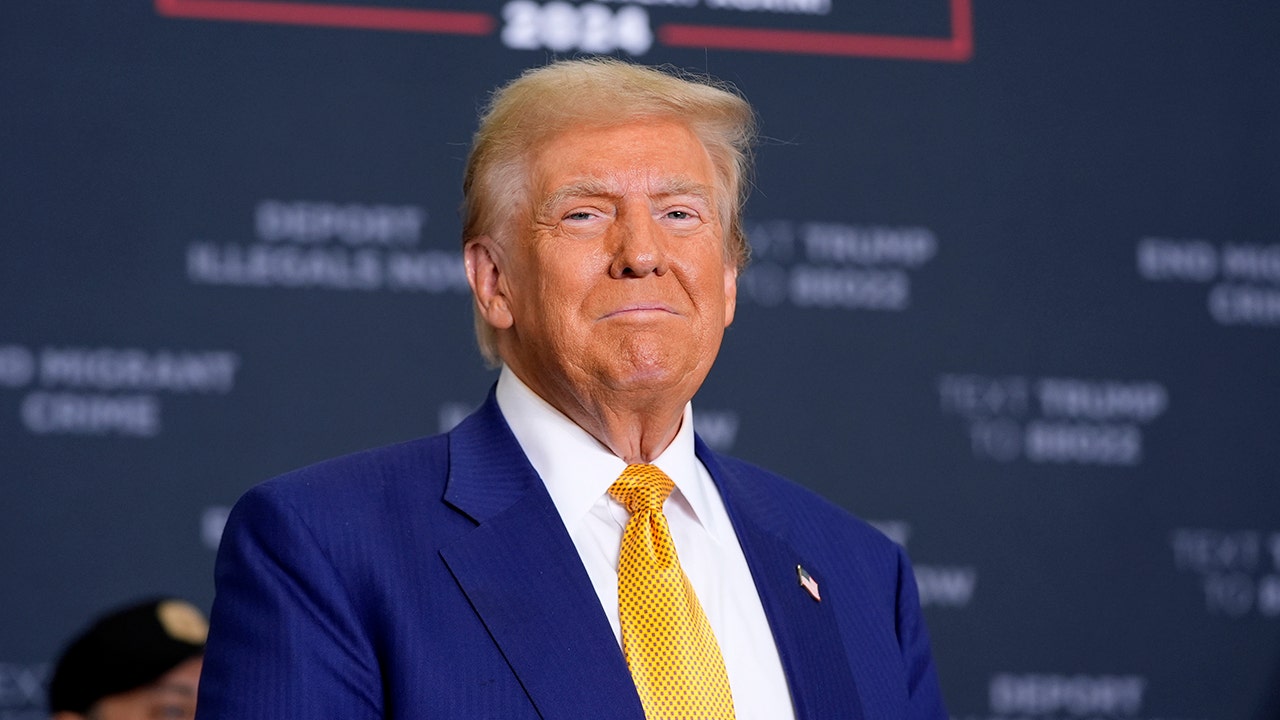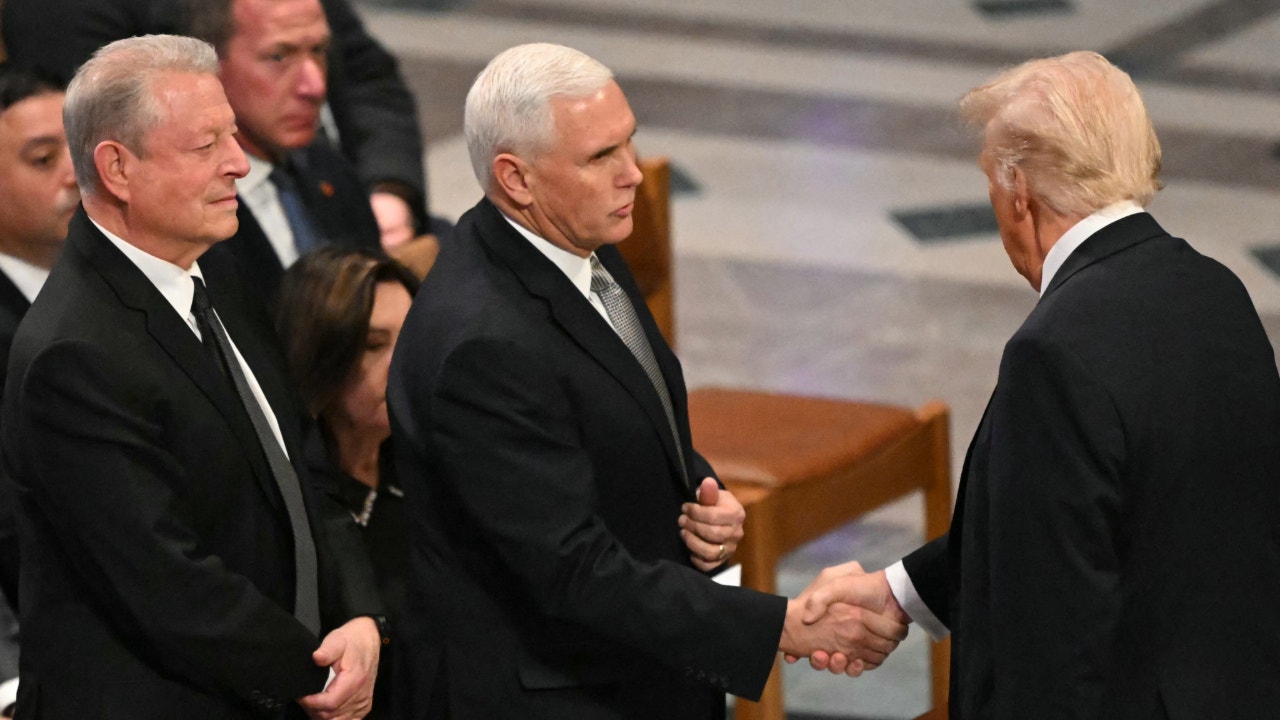Business
Black-trimmed homes, tiny libraries and other signs your neighborhood is about to be gentrified

A shift in demographics. Affordable apartments transformed into luxury condos. A coffee shop called something like “Brew Slut.”
The signs of gentrification take many forms. A newly opened art gallery can serve both as a communal space and a harbinger of the displacement to come. Remodeled homes might boost a street’s curb appeal but then drive up rents in the ensuing months and years.
There are plenty of ways to tell when gentrification is coming to a community; rising home prices and an influx of trendy shops are classic omens. But in the modern market, developers are flipping houses at the highest rate since 2000, and the houses they churn out are often homogeneous: boxy, black and white, minimalist. They’re adorned with trendy house number fonts and chic drought-tolerant gardens, and they can be an obvious sign of gentrification on the way.
Take a stroll through your neighborhood and keep an eye out for these trends. If you spot a few, gentrification may be on the way. If you spot a bunch, it might be well underway.
The gentrification font
If Neutraface starts speckling the homes and fences around your neighborhood, your rent might soar soon.
The sleek typeface and its many knock-offs have become so commonplace that they’ve become a meme, and the Guardian even declared it “the gentrification font.” It crowns countless brand-new builds across L.A., and like certain wines and cheeses, it pairs well with cheaply done fixer-uppers or the aforementioned box houses.
House numbers are presented in a chic font.
(Jack Flemming / Los Angeles Times)
“The Shake Shack font has invaded,” said Steven Sanders, a Highland Park resident who has lived in the rapidly changing neighborhood since 2015. When Sanders moved there, the median single-family home value was around $463,000, according to Zillow. Today, it’s $1.002 million.
There’s nothing specifically wrong with the font; it’s clean, modern and easy to read. Ironically, it’s named after Richard Neutra, an iconic architect who often stressed affordability in his work.
If a for-sale house has a Neutraface house number, the listing price will probably be anything but affordable.
Gentrification bonus point: if the font is also brass or gold.
Black-and-white paint jobs
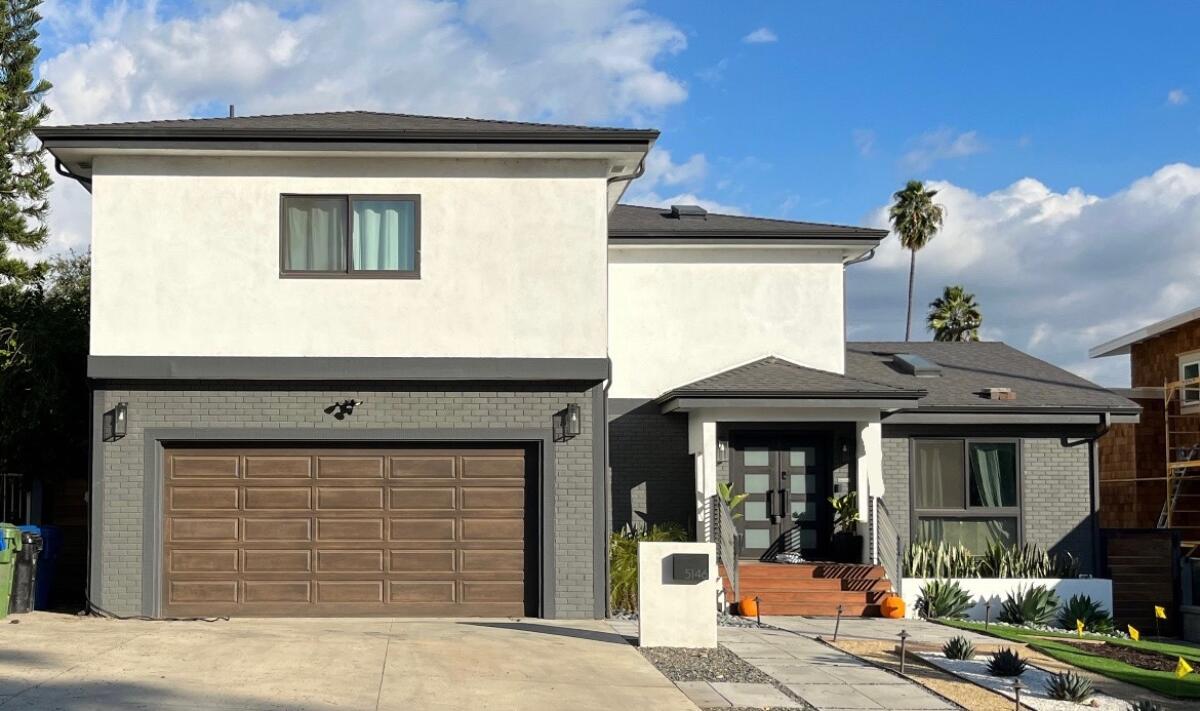
This two-story home features a black-and-white exterior.
(Jack Flemming / Los Angeles Times)
Gentrification, in terms of housing, has become a monochromatic movement. Gone are the green-colored Craftsmans or the pink-hued bungalows of old; today, newly built homes are overwhelmingly white, black or a brutal combination of the two.
“Taste aside, a black house in an era of climate change is ridiculous,” said Adam Greenfield, a transportation and land-use advocate.
Gentrification bonus point: if a black-and-white exterior comes with an accent door — a splash of bright blue, yellow or turquoise to showcase that the property isn’t completely devoid of character. Just mostly devoid of character.
Excess security cameras
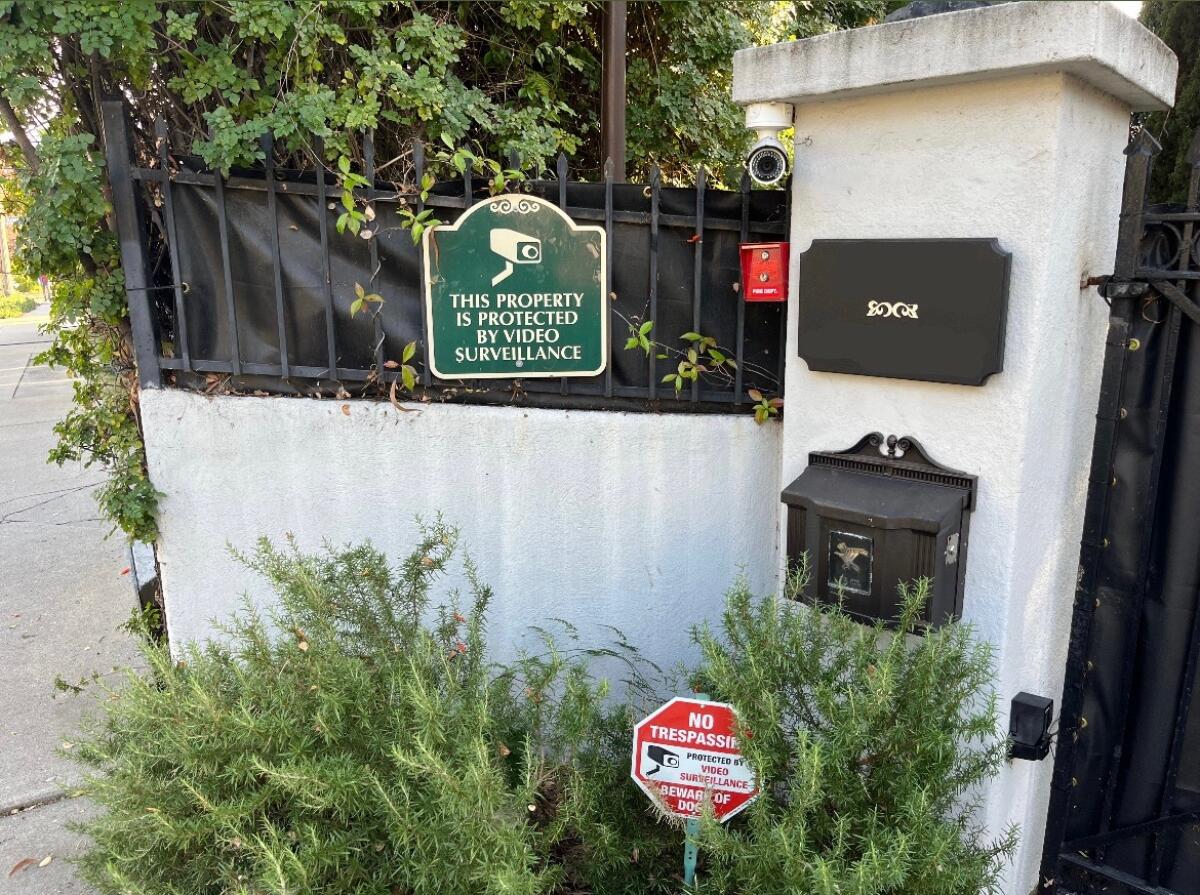
Multiple cameras are posted outside an Eagle Rock home.
(Jack Flemming / Los Angeles Times)
If you’re taking a stroll down your street and feel watched — not by anyone specific, but by a small army of Ring doorbells, Nest cameras and other electronic eyes making sure you don’t pick a Meyer lemon or that your dog doesn’t defecate on the decomposed granite — brace for a new brand of neighbor.
Surveillance systems and the context behind them, in which owners view their neighbors and passersby as potential package-stealers, are all too common in gentrifying communities. For if it were truly a high-crime place, there would still be chain link and barred windows.
There’s plenty of evidence that smart doorbells lead to racial profiling, and while there’s nothing inherently wrong with security systems, they generally detract from the community feel instead of adding to it.
“It’s the degradation of the social fabric that for so long we all took for granted,” Greenfield said. “It’s legitimate to walk up to a neighbor’s door to ask for or offer something, and security cameras and warning systems discourage that. We can’t let fear win in our society.”
Gentrification bonus point: if they come with a speaker with a disembodied voice that barks at passersby in a condescending tone: “Hi! You are currently being recorded.”
Privacy fences
Sometimes, surveillance systems aren’t enough. Many modern homeowners moving into new neighborhoods don’t even want to be seen by neighbors, so they install privacy fences or towering hedges to shield themselves from anyone walking by.
Greenfield calls them “f— you fences.”
“Many people were raised in the suburban sprawl, where they don’t have as much access to other people. Then they move to denser areas and import those suburban norms of separation and privacy,” Greenfield said.
Lola Rodriguez, a Lincoln Heights resident who grew up in the area, said if a home in the neighborhood is ever hidden from view, it’s usually someone who just moved in.
Gentrification bonus point: if the privacy fence is chic and stylish, like the horizontal trend that has taken over in some areas.
Box houses
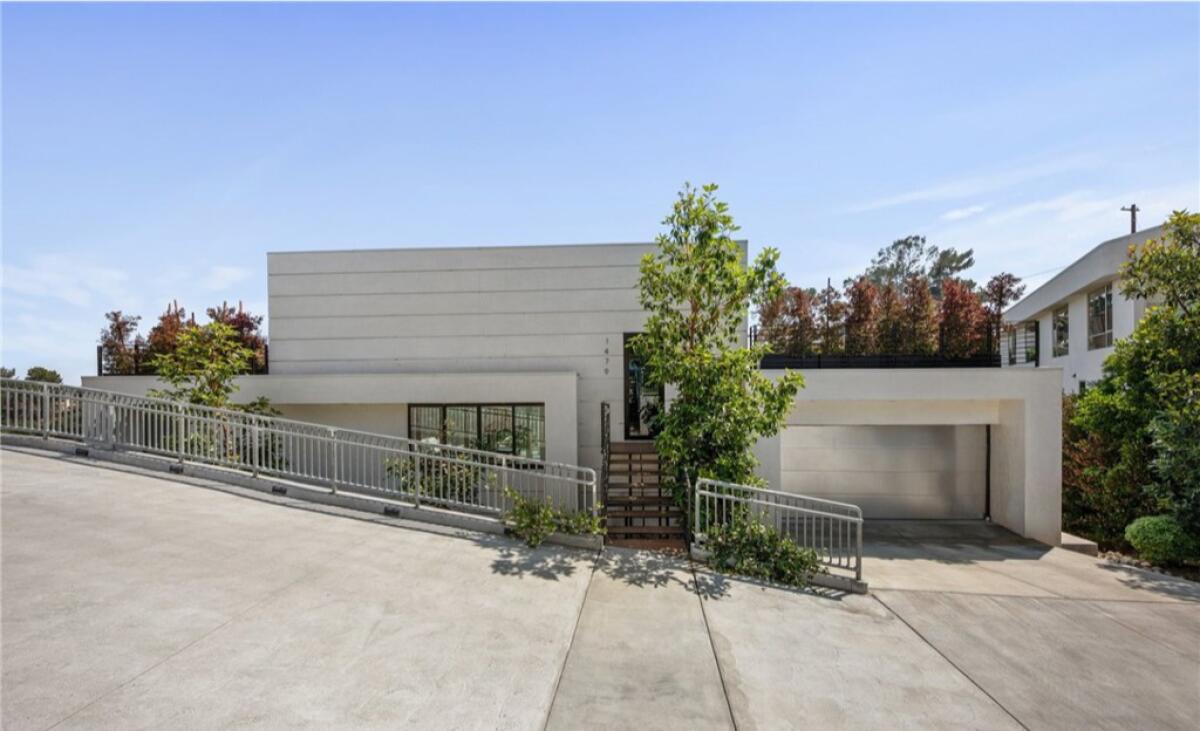
This modern five-bedroom home listed by Avo Atnalian in the hills of Highland Park is on the market for $2.498 million.
(Avo Atnalian)
One of the more uninspired architectural trends of the last century, modern box houses forgo attempts at character or ornamentation, instead serving as shrines to simplicity. They worship at the altar of minimalism, squeezing out as much square footage as zoning laws will allow.
They’re clean, they’re simple, and they’re a likely sign that a new demographic is moving into a neighborhood.
“It’s jarring seeing a bright white box house jammed between older houses with more character,” Rodriguez said. She prefers the neighborhood’s stock of century-old bungalows over the new homes being built.
The polarizing style isn’t for everyone, but it’s a hit for deep-pocketed buyers eyeing extra space. And box houses are quicker and cheaper to build for profit-minded developers, who will keep cranking out supply as long as there’s demand.
Gentrification bonus point: if the box house includes a glass garage door.
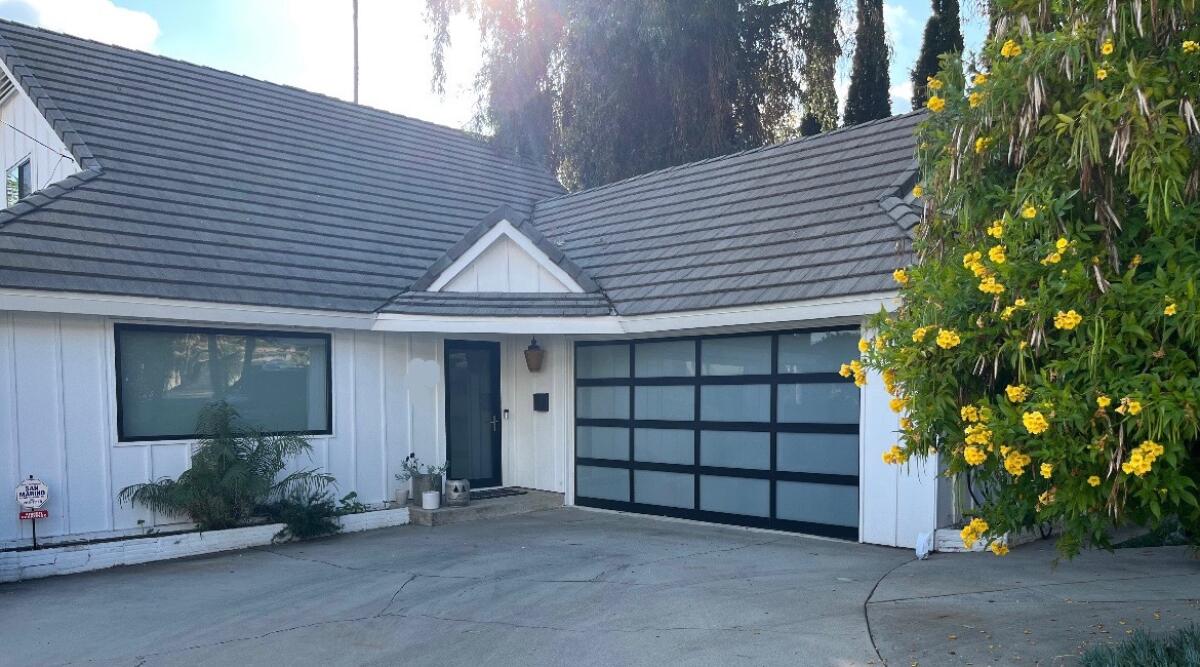
This modern home features a glass garage door.
(Jack Flemming / Los Angeles Times)
Drought-tolerant gardens
To be clear, the ecological benefits of drought-tolerant landscaping make it a net positive for Southern California. Limited water usage is absolutely a good thing.
But such gardens aren’t always cheap, and if they start popping up in neighborhoods where most residents can’t afford to spend thousands of dollars, sometimes tens of thousands, on their yard, it could be a sign of gentrification.
Most carry the same look: a handful of shrubs, succulents and cacti surrounded by gravel or decomposed granite, giving it a sandy, desert-like quality.
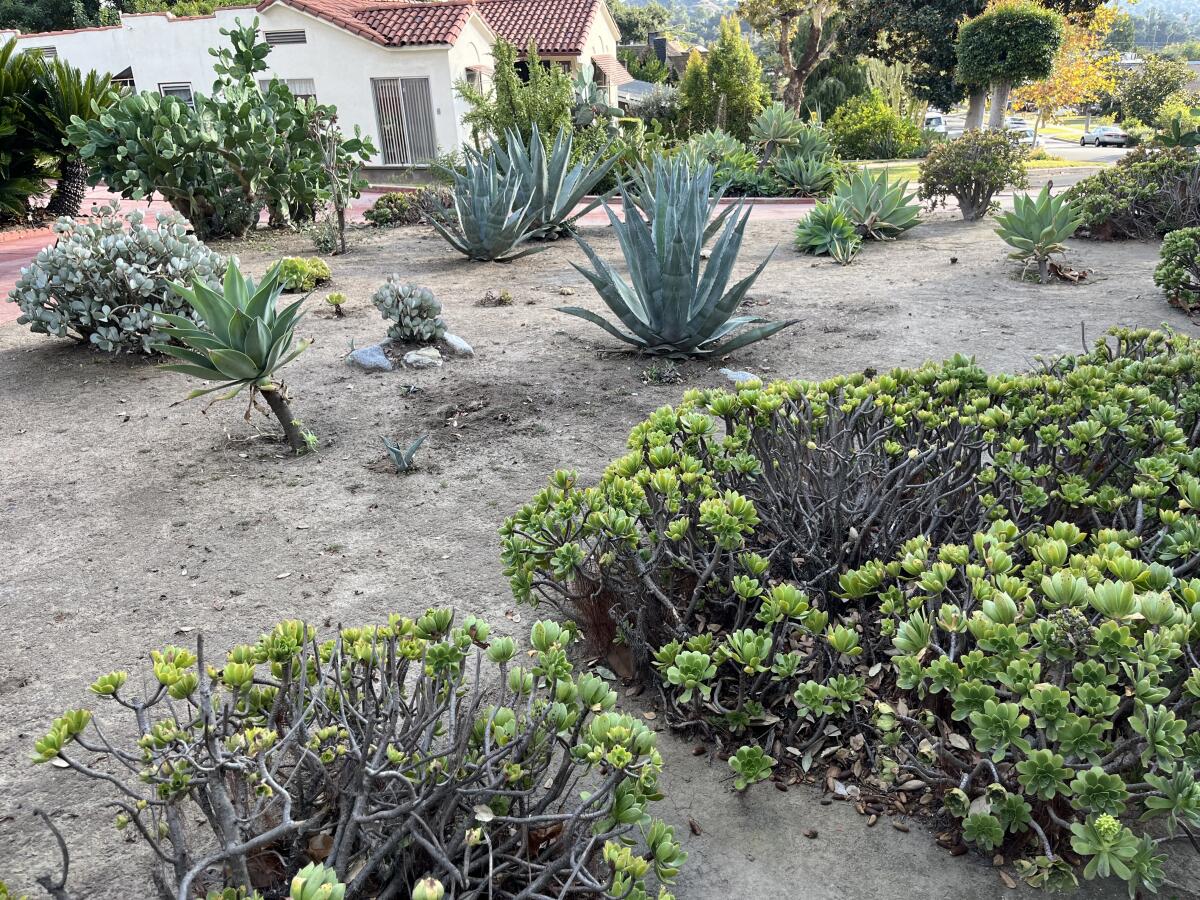
Drought-tolerant plants outside an Eagle Rock home.
(Jack Flemming / Los Angeles Times)
Kerry Kimble and Steven Galido, two real estate agents with the Agency, said they’ve noticed an increase in drought-tolerant gardens in neighborhoods such as Echo Park, Highland Park and Silver Lake, where displacement has already been happening for years.
The majority of Kimble’s listings are in northeast L.A., and she said she’s noticed a surplus of succulents.
Galido said some developers add drought-tolerant gardens to attract potential buyers.
“Developers remodel homes for the taste of the gentrifier,” he said.
The pair are currently listing a 106-year-old duplex in Angelino Heights, a neighborhood protected by a Historic Preservation Overlay Zone, which preserves a community’s architectural feel by limiting new building designs and renovations. But not every neighborhood enjoys such protection.

Firestick plants fill the gardens of many homes in gentrified neighborhoods.
(Jack Flemming / Los Angeles Times)
Gentrification bonus point: if the garden is riddled with Firestick plants — the trendy, orange-tipped succulents that seem to anchor every lawn in those “up-and-coming” neighborhoods.
Little Free Libraries
Listen, these are lovely. Unlike surveillance systems and privacy fences, little libraries actually evoke a sense of community, bringing neighbors together over a shared love of literature (even though most generally seem to be stocked exclusively with James Patterson novels and unreadable how-to books).
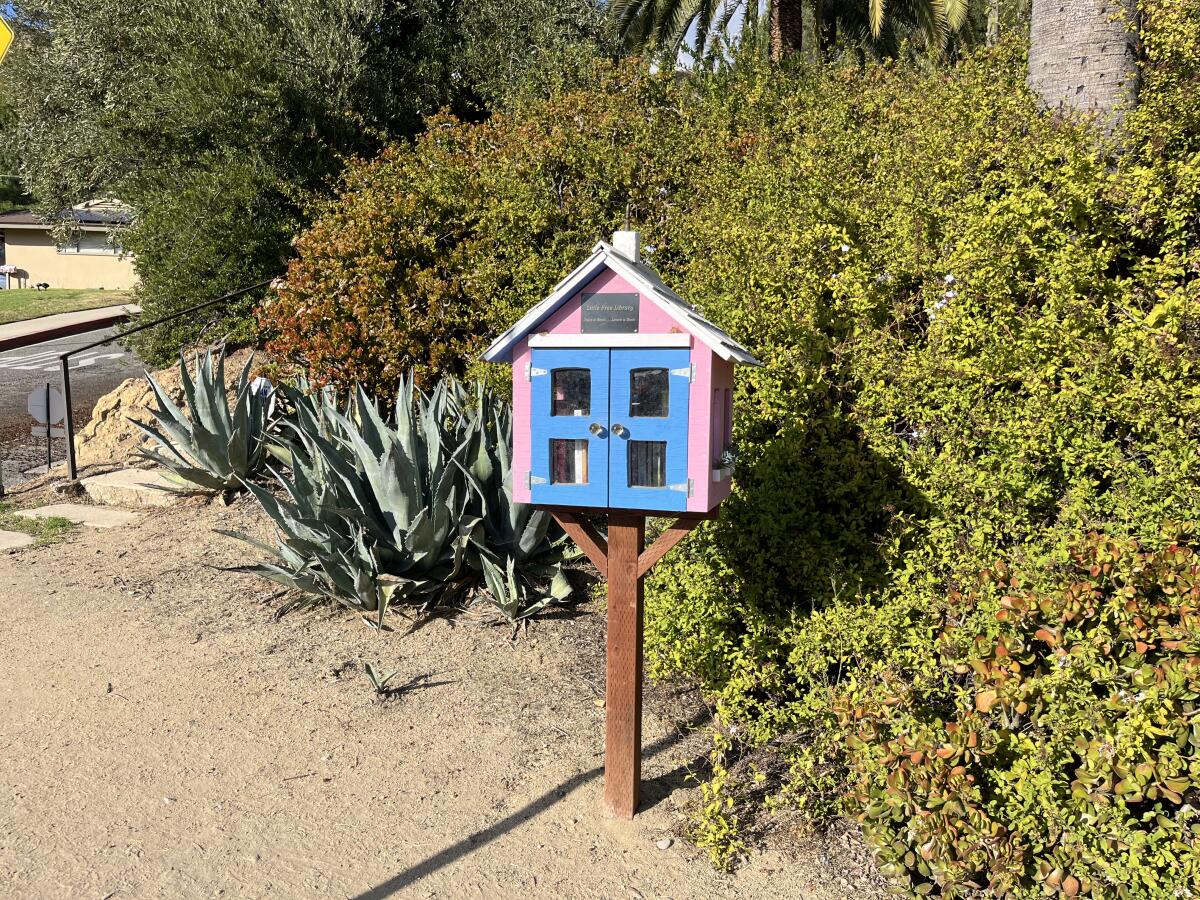
A Little Free Library is posted outside a home.
(Jack Flemming / Los Angeles Times)
The charming, birdhouse-like structures certainly don’t cause gentrification, despite what a handful of critics have claimed over the years. But they definitely seem to be a product of gentrification, usually popping up in areas where home prices are rising and well-to-do residents are moving in.
Gentrification bonus point: if a smart doorbell camera watches over the library, making sure nobody takes more than their fair share of books.
Pointed listing language
Sometimes, the clearest sign of gentrification is hearing how people are talking about a neighborhood and the homes within it. There’s a wealth of such examples posted daily on Zillow, Redfin and other listing sites as real estate agents take on certain tones to market properties to potential buyers.
For example, if a listing brags about the home being some kind of port in a storm, a refuge from the area around it, a ship of gentrifiers might be sailing in. One listing in Boyle Heights is touted as an “urban oasis.” Another in South L.A. promises to add “a touch of serenity to urban living.”
Also pay attention to whether a listing is marketed as an actual place to live or simply an investment opportunity. This listing near Leimert Park asks potential buyers to “come see your future investment today.” An Elysian Heights listing touts its use as an Airbnb.
Gentrification bonus point: if the language sounds like an extra flowery wellness ad, such as this listing in East L.A.: “Imagine stepping into a world where every corner whispers tales of renewal.”

Business
Inside Elon Musk’s Plan for DOGE to Slash Government Costs

An unpaid group of billionaires, tech executives and some disciples of Peter Thiel, a powerful Republican donor, are preparing to take up unofficial positions in the U.S. government in the name of cost-cutting.
As President-elect Donald J. Trump’s so-called Department of Government Efficiency girds for battle against “wasteful” spending, it is preparing to dispatch individuals with ties to its co-leaders, Elon Musk and Vivek Ramaswamy, to agencies across the federal government.
After Inauguration Day, the group of Silicon Valley-inflected, wide-eyed recruits will be deployed to Washington’s alphabet soup of agencies. The goal is for most major agencies to eventually have two DOGE representatives as they seek to cut costs like Mr. Musk did at X, his social media platform.
This story is based on interviews with roughly a dozen people who have insight into DOGE’s operations. They spoke to The Times on the condition of anonymity because they were not authorized to speak publicly.
On the eve of Mr. Trump’s presidency, the structure of DOGE is still amorphous and closely held. People involved in the operation say that secrecy and avoiding leaks is paramount, and much of its communication is conducted on Signal, the encrypted messaging app.
Mr. Trump has said the effort would drive “drastic change,” and that the entity would provide outside advice on how to cut wasteful spending. DOGE itself will have no power to cut spending — that authority rests with Congress. Instead, it is expected to provide recommendations for programs and other areas to cut.
But parts of the operation are becoming clear: Many of the executives involved are expecting to do six-month voluntary stints inside the federal government before returning to their high-paying jobs. Mr. Musk has said they will not be paid — a nonstarter for some originally interested tech executives — and have been asked by him to work 80-hour weeks. Some, including possibly Mr. Musk, will be so-called special government employees, a specific category of temporary workers who can only work for the federal government for 130 days or less in a 365-day period.
The representatives will largely be stationed inside federal agencies. After some consideration by top officials, DOGE itself is now unlikely to incorporate as an organized outside entity or nonprofit. Instead, it is likely to exist as more of a brand for an interlinked group of aspirational leaders who are on joint group chats and share a loyalty to Mr. Musk or Mr. Ramaswamy.
“The cynics among us will say, ‘Oh, it’s naïve billionaires stepping into the fray.’ But the other side will say this is a service to the nation that we saw more typically around the founding of the nation,” said Trevor Traina, an entrepreneur who worked in the first Trump administration with associates who have considered joining DOGE.
“The friends I know have huge lives,” Mr. Traina said, “and they’re agreeing to work for free for six months, and leave their families and roll up their sleeves in an attempt to really turn things around. You can view it either way.”
DOGE leaders have told others that the minority of people not detailed to agencies would be housed within the Executive Office of the President at the U.S. Digital Service, which was created in 2014 by former President Barack Obama to “change our government’s approach to technology.”
DOGE is also expected to have an office in the Office of Management and Budget, and officials have also considered forming a think tank outside the government in the future.
Mr. Musk’s friends have been intimately involved in choosing people who are set to be deployed to various agencies. Those who have conducted interviews for DOGE include the Silicon Valley investors Marc Andreessen, Shaun Maguire, Baris Akis and others who have a personal connection to Mr. Musk. Some who have received the Thiel Fellowship, a prestigious grant funded by Mr. Thiel given to those who promise to skip or drop out of college to become entrepreneurs, are involved with programming and operations for DOGE. Brokering an introduction to Mr. Musk or Mr. Ramaswamy, or their inner circles, has been a key way for leaders to be picked for deployment.
That is how the co-founder of Loom, Vinay Hiremath, said he became involved in DOGE in a rare public statement from someone who worked with the entity. In a post this month on his personal blog, Mr. Hiremath described the work that DOGE employees have been doing before he decided against moving to Washington to join the entity.
“After 8 calls with people who all talked fast and sounded very smart, I was added to a number of Signal groups and immediately put to work,” he wrote. “The next 4 weeks of my life consisted of 100s of calls recruiting the smartest people I’ve ever talked to, working on various projects I’m definitely not able to talk about, and learning how completely dysfunctional the government was. It was a blast.”
These recruits are assigned to specific agencies where they are thought to have expertise. Some other DOGE enrollees have come to the attention of Mr. Musk and Mr. Ramaswamy through X. In recent weeks, DOGE’s account on X has posted requests to recruit a “very small number” of full-time salaried positions for engineers and back-office functions like human resources.
The DOGE team, including those paid engineers, is largely working out of a glass building in SpaceX’s downtown office located a few blocks from the White House. Some people close to Mr. Ramaswamy and Mr. Musk hope that these DOGE engineers can use artificial intelligence to find cost-cutting opportunities.
The broader effort is being run by two people with starkly different backgrounds: One is Brad Smith, a health care entrepreneur and former top health official in Mr. Trump’s first White House who is close with Jared Kushner, Mr. Trump’s son-in-law. Mr. Smith has effectively been running DOGE during the transition period, with a particular focus on recruiting, especially for the workers who will be embedded at the agencies.
Mr. Smith has been working closely with Steve Davis, a collaborator of Mr. Musk’s for two decades who is widely seen as working as Mr. Musk’s proxy on all things. Mr. Davis has joined Mr. Musk as he calls experts with questions about the federal budget, for instance.
Other people involved include Matt Luby, Mr. Ramaswamy’s chief of staff and childhood friend; Joanna Wischer, a Trump campaign official; and Rachel Riley, a McKinsey partner who works closely with Mr. Smith.
Mr. Musk’s personal counsel — Chris Gober — and Mr. Ramaswamy’s personal lawyer — Steve Roberts — have been exploring various legal issues regarding the structure of DOGE. James Burnham, a former Justice Department official, is also helping DOGE with legal matters. Bill McGinley, Mr. Trump’s initial pick for White House counsel who was instead named as legal counsel for DOGE, has played a more minimal role.
“DOGE will be a cornerstone of the new administration, helping President Trump deliver his vision of a new golden era,” said James Fishback, the founder of Azoria, an investment firm, and confidant of Mr. Ramaswamy who will be providing outside advice for DOGE.
Despite all this firepower, many budget experts have been deeply skeptical about the effort and its cost-cutting ambitions. Mr. Musk initially said the effort could result in “at least $2 trillion” in cuts from the $6.75 trillion federal budget. But budget experts say that goal would be difficult to achieve without slashing popular programs like Social Security and Medicare, which Mr. Trump has promised not to cut.
Both Mr. Musk and Mr. Ramaswamy have also recast what success might mean. Mr. Ramaswamy emphasized DOGE-led deregulation on X last month, saying that removing regulations could stimulate the economy and that “the success of DOGE can’t be measured through deficit reduction alone.”
And in an interview last week with Mark Penn, the chairman and chief executive of Stagwell, a marketing company, Mr. Musk downplayed the total potential savings.
“We’ll try for $2 trillion — I think that’s like the best-case outcome,” Mr. Musk said. “You kind of have to have some overage. I think if we try for two trillion, we’ve got a good shot at getting one.”
Business
They lost their home insurance policies. Then came the fires
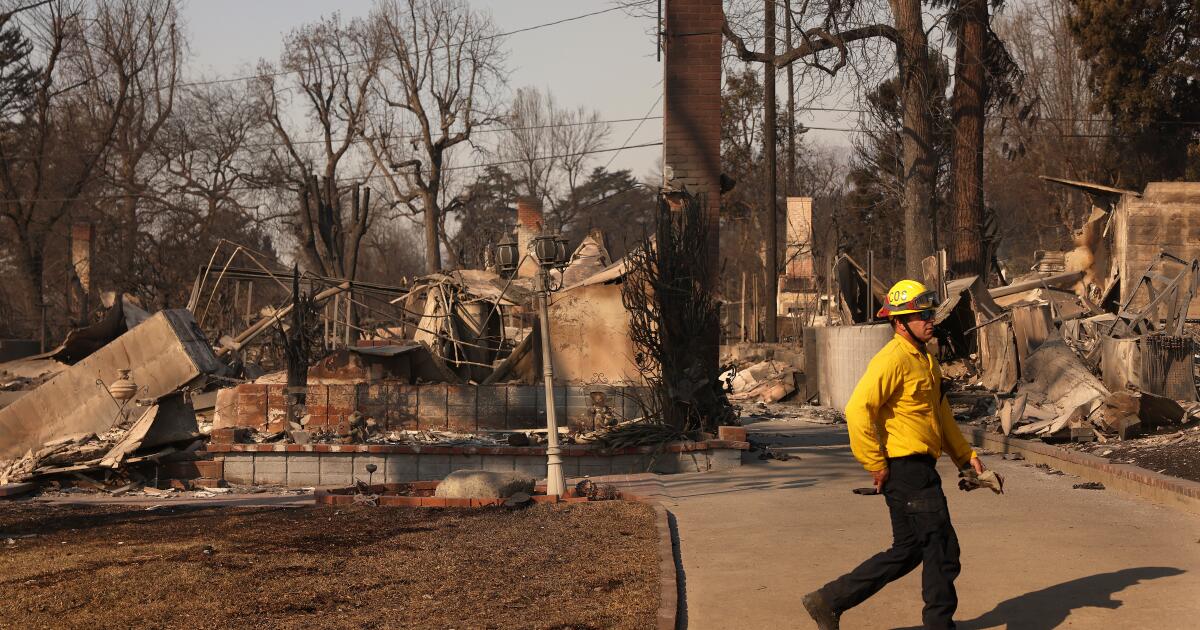
Last year, Francis Bischetti said he learned that the annual cost of the homeowners policy he buys from Farmers Insurance for his Pacific Palisades home was going to soar from $4,500 to $18,000 — an amount he could not possibly afford.
Neither could he get onto California FAIR Plan, which provides fewer benefits, because he said he would have to cut down 10 trees around his roof line to lower the fire risk — something else the 55-year-old personal assistant found too costly to manage.
So he decided he would do what’s called “going bare” — not buying any coverage on his home in the community’s El Medio neighborhood. He figured if he watered his property year round, that might be protection enough given its location south of Sunset Boulevard.
It wasn’t. The home he lived in for nearly all his life burned down Tuesday along with more than 10,000 other homes and structures damaged or destroyed in the worst fire event in the history of Los Angeles. Sixteen deaths have been confirmed countywide.
“It was surrealistic,” he said. “I’ve grown up and lived here off and on for 50 years. I’ve never in my entire time here experienced this.”
Farmers Insurance declined to comment, saying it does not discuss individual policyholders.
‘A train wreck coming down the track’
Bischetti was far from the only homeowner living in Pacific Palisades, Altadena or other fire-prone hillside neighborhoods who struggled to maintain their insurance amid sharply rising costs and the decision by many insurers to reduce their exposure to catastrophic wildfire claims by not renewing the policies of even longtime customers. Many fire victims reported that insurers had dropped their policies last year.
The fires — expected to be among the costliest natural disasters in U.S. history — have deepened a crisis in the state’s home insurance market that was already reeling before the devastation came.
The state’s largest home insurer, State Farm General, announced in March it would not renew 30,000 homeowner and condominium policies — including 1,626 in Pacific Palisades — when they expired.
Chubb and its subsidiaries stopped writing new policies for high-value homes with higher wildfire risk. Allstate has stopped writing new policies, and Tokio Marine America Insurance Co. and Trans Pacific Insurance Co. pulled out of the state, though Mercury Insurance offered to take their customers.
Liberty Mutual was sued last month by a homeowner who accused the insurer of dropping her over a bogus claim that her roof had mold damage.
“Driven by a desire to maximize profits, property casualty insurance companies … have engaged in a troubling trend of dropping California homeowners’ insurance policies like flies,” said the complaint, filed in San Diego County Superior Court. A spokesperson for Liberty Mutual declined to comment on the litigation.
The inability to get coverage is reflected in the number of policies picked up by California FAIR Plan, which as of September had about 452,000 policies, up from a little over 203,000 four years ago. FAIR Plan’s website says its claims exposure is nearly $6 billion in Pacific Palisades alone.
“The situation has been a train wreck coming down the track for a while,” said Rick Dinger, president of Crescenta Valley Insurance, an independent brokerage in Glendale.
Not enough insurance money to rebuild
Peggy Holter spent decades as a television journalist, a peripatetic career that took her all over the world, but there was one place she called home and always returned to: the Pacific Palisades condo she moved into on Jan. 1, 1978. That all changed after Tuesday’s firestorm, when her condo burned to the ground along with the rest of the 36 units in the Palisades Drive complex.
Holter, 83, who only retired last year, is now facing uncertainty after she said State Farm didn’t renew her individual condo insurance, citing the condition of her roof.
But with the loss of her documents she isn’t sure if and when the policy lapsed — and she hadn’t yet secured a new carrier. The insurance typically covers personal belongings and a unit’s interior and provides benefits such as living expenses if a condo becomes unusable.
“I’m not a big keeper of things, but what I did have was a whole wall of pictures and albums of all the places I had been, family photos. I had a picture of my mother on a camel when she was 52 in front of the Sphinx,” Holter recalled. “The only thing I am concerned about is the future, because that is what you have to do.”
Her biggest question is whether she can rebuild. The homeowners association had a master policy from FAIR Plan, which totaled only $20 million. That would pay out only about $550,000 per unit if the complex were not rebuilt — far below the $1 million-plus the condos commanded in recent sales. The land could be sold off to a developer.
Holter, who is now living with her son in the Hollywood Hills, had paid off her condo.
She went back to the complex after the fires died down to get a closer look at the damage. There was nothing left of her unit, but the complex’s koi pond survived, along with the fish.
State Farm has declined to comment on its non-renewals, saying in a recent statement: “Our number one priority right now is the safety of our customers, agents and employees impacted by the fires and assisting our customers in the midst of this tragedy.”
‘We don’t cover anything in California’
Matt Knight considers himself fortunate: He and his family could have lost it all in the Eaton fire, just like Bischetti and Holter in the Palisades fire.
The trouble started last year he said when he received a notice from Safeco Insurance that the policy on his Sonoma Drive home in Altadena, where he lives with his wife and three children, would not be renewed due to a tree overhanging his garage.
The 45-year-old Covina elementary school teacher said he dutifully trimmed the tree only to be told the ivy growing on the garage also was a problem. After removing that, he said he was told he had to fix his damaged stucco, which forced him to paint his house and in the process replace his old roof. Yet he said he still couldn’t get insurance after spending $30,000 on the repairs.
A spokesperson for Safeco, a subsidiary of Liberty Mutual, said the carrier does not comment on individual policyholders.
“So we went looking company after company after company, and some of them would say, ‘No, we don’t cover anything in California.’ Some said, ‘We’re not doing any new policies.’ Some said, ‘No, we don’t do 91001 because it’s in a fire zone, and we were were like, ‘That’s crazy.’”
Just a day before his policy was set to expire last summer, Knight said he finally managed to secure similar coverage with Aegis Insurance. But in the haste to get the policy in force, the home he has lived in for 16 years was left wildly under-insured for less than $300,000. The home is valued at $1.13 million on Zillow.
The ferocious winds that fanned the Eaton fire started a power outage Tuesday evening, so Knight decided to drive his children over to his parents’ home on the other side of Altadena where they could do their homework. From there, he saw the fire start on a street hugging the mountains near what appeared to be a power line.
“Within minutes it was taken up the hillside. It was unbelievable,” he said.
His parents’ home on Roosevelt Avenue escaped the devastation, and throughout the night he drove over to check on his home. By 6 a.m., he had joined a brigade of homeowners to fight the encroaching flames on Sonoma Drive. “The whole neighborhood was there grabbing hoses and fighting fires,” he said.
In the late afternoon, he said, the water ran out for the homeowners and firefighters alike, forcing him and his neighbors to pack up and go. He was sure he would lose his home, but the winds died down.
“I think that was the ultimate good fortune,” he said, though some other neighbors were not so lucky.
Bischetti was not so lucky either.
On Tuesday, when the fires started in the hills and all of his Palisades neighbors started to pack their cars, Bischetti stayed behind to keep hosing down his property, including his lawn, roof, rafters and walls.
“I thought everything would be relatively safe,” he said. “I was sticking around trying to protect the house with water.”
He gradually started packing his car with a change of clothes, one of his guitars, tax papers, property deeds and hard drives from his computer. He left his computer itself back in the house, along with his amps, music equipment and tools.
His entire street was a ghost town by 5 p.m. By then, Bischetti had already watered down his property multiple times. It was dusty and smoky, and a voice in his head told him it was time to go. “I’m going to come back for this tomorrow,” he recalled thinking. “I don’t want to weigh down my car.”
It didn’t work out that way.
Bischetti drove near Palisades High School and saw a house on the corner of the street start to burn down. He then tried going on El Medio Avenue and drove into black smoke, with flames on both sides of his car. He started panicking and realized he couldn’t get through.
After making it to his sister’s home in Mar Vista, he found out from a neighbor that all of the homes on his block had been leveled.
Bischetti said his siblings lost family mementos and photos and he lost thousands of dollars’ worth of tools and musical instruments. They also had spent nearly $4,000 fixing up the home in order to rent out some of the rooms.
Bischetti and his family have signed up for Federal Emergency Management Agency disaster relief funds and are trying to get help with cleaning up the property, which he said could cost at least $10,000.
“I was getting ready for this,” he said of his one-man firefighting efforts. “That was the last hurrah.”
Business
4 Takeaways From the Arguments Before the Supreme Court in the TikTok Case

The Supreme Court on Friday grappled over a law that could determine the fate of TikTok, an enormously popular social media platform that has about 170 million users.
Congress enacted the law out of concern that the app, whose owner is based in China, is susceptible to the influence of the Chinese government and posed a national risk. The measure would effectively ban TikTok from operating in the United States unless its owner, ByteDance, sells it by Jan. 19.
Here are some key takeaways:
The court appeared likely to uphold the law.
While the justices across the ideological spectrum asked tough questions of both sides, the overall tone and thrust appeared to suggest greater skepticism toward the arguments by lawyers for TikTok and its users that the First Amendment barred Congress from enacting the law.
The questioning opened with two conservative members of the court, Justice Clarence Thomas and Chief Justice John G. Roberts Jr., suggesting that it was not TikTok, an American company, but its Chinese parent company, ByteDance, that was directly affected by the law.
Another conservative, Justice Brett M. Kavanaugh, focused on the risk that the Chinese government could use information TikTok is gathering on tens of millions of American teenagers and twentysomethings to eventually “develop spies, turn people, blackmail people” when they grow older and go to work for national security agencies or the military.
Justice Elena Kagan, a liberal, asked why TikTok could not just create or buy another algorithm rather than using ByteDance’s.
And another liberal, Justice Ketanji Brown Jackson, said she believed the law was less about speech than about association. She suggested that barring TikTok from associating with a Chinese company was akin to barring Americans from associating with foreign terrorist groups for national security reasons. (The Supreme Court has upheld that as constitutional.)
Still, several justices were skeptical about a major part of the government’s justification for the law: the risk that China might “covertly” make TikTok manipulate the content shown to Americans or collect user data to achieve its geopolitical aims.
Both Justice Kagan and Justice Neil M. Gorsuch, a conservative, stressed that everybody now knows that China is behind TikTok. They appeared interested in whether the government’s interest in preventing “covert” leveraging of the platform by a foreign adversary could be achieved in a less heavy-handed manner, like appending a label warning users of that risk.
Lawyers for TikTok and for its users argued that the law is unconstitutional.
Two lawyers argued that the law violates the First Amendment: Noel Francisco, representing both TikTok and ByteDance, and Jeffrey Fisher, representing TikTok users. Both suggested that concerns about potential manipulation by the Chinese government of the information American users see on the platform were insufficient to justify the law.
Mr. Francisco contended that the government in a free country “has no valid interest in preventing foreign propaganda” and cannot constitutionally try to keep Americans from being “persuaded by Chinese misinformation.” That is targeting the content of speech, which the First Amendment does not permit, he said.
Mr. Fisher asserted that fears that China might use its control over the platform to promote posts sowing doubts about democracy or pushing pro-China and anti-American views were a weaker justification for interfering in free speech than concerns about foreign terrorism.
“The government just doesn’t get to say ‘national security’ and the case is over,” Mr. Fisher said, adding, “It’s not enough to say ‘national security’ — you have to say ‘what is the real harm?’”
The Biden administration defended Congress’s right to enact the law.
The solicitor general, Elizabeth B. Prelogar, argued that Congress had lawful authority to enact the statute and that it did not violate the First Amendment. She said it was important to recognize that the law leaves speech on TikTok unrestricted once the platform is freed from foreign control.
“All of the same speech that’s happening on TikTok could happen post-divestiture,” she said. “The act doesn’t regulate that at all. So it’s not saying you can’t have pro-China speech, you can’t have anti-American speech. It’s not regulating the algorithm.”
She added: “TikTok, if it were able to do so, could use precisely the same algorithm to display the same content by the same users. All the act is doing is trying to surgically remove the ability of a foreign adversary nation to get our data and to be able to exercise control over the platform.”
The court appears unlikely to wait for Trump.
President-elect Donald J. Trump has asked the Supreme Court to issue an injunction delaying the law from taking effect until after he assumes office on Jan. 20.
Mr. Trump once shared the view that Chinese control of TikTok was an intolerable national security risk, but reversed course around the time he met with a billionaire Republican donor with a stake in its parent company.
If the court does uphold the law, TikTok would effectively be banned in the United States on Jan. 19, Mr. Francisco said. He reiterated a request that the court temporarily pause the law from taking effect to push back that deadline, saying it would “simply buy everybody a little breathing space.” It might be a “different world” for TikTok after Jan. 20, he added.
But there was scant focus by the justices on that idea, suggesting that they did not take it seriously. Mr. Trump’s brief requesting that the court punt the issue past the end of President Biden’s term so he could handle it — signed by his pick to be the next solicitor general, D. John Sauer — was long on rhetoric extolling Mr. Trump, but short on substance.
-

 Politics1 week ago
Politics1 week agoNew Orleans attacker had 'remote detonator' for explosives in French Quarter, Biden says
-

 Politics1 week ago
Politics1 week agoCarter's judicial picks reshaped the federal bench across the country
-

 Politics1 week ago
Politics1 week agoWho Are the Recipients of the Presidential Medal of Freedom?
-

 Health7 days ago
Health7 days agoOzempic ‘microdosing’ is the new weight-loss trend: Should you try it?
-

 World1 week ago
World1 week agoSouth Korea extends Boeing 737-800 inspections as Jeju Air wreckage lifted
-
/cdn.vox-cdn.com/uploads/chorus_asset/file/25822586/STK169_ZUCKERBERG_MAGA_STKS491_CVIRGINIA_A.jpg)
/cdn.vox-cdn.com/uploads/chorus_asset/file/25822586/STK169_ZUCKERBERG_MAGA_STKS491_CVIRGINIA_A.jpg) Technology3 days ago
Technology3 days agoMeta is highlighting a splintering global approach to online speech
-
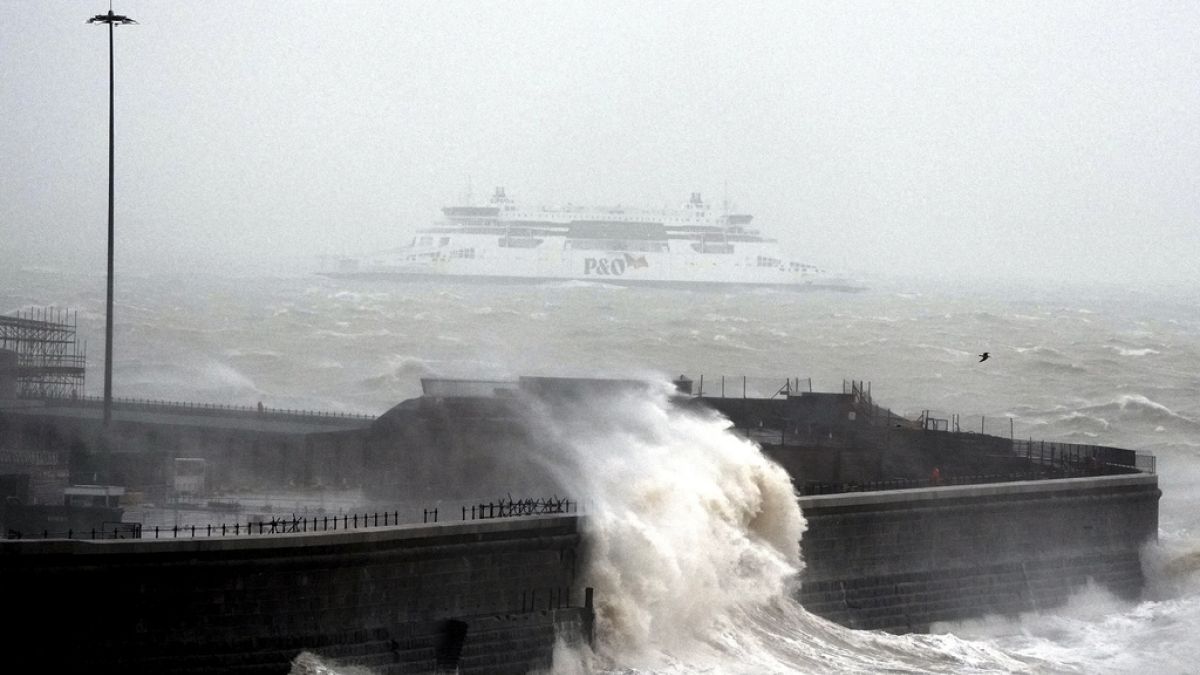
 World1 week ago
World1 week agoWeather warnings as freezing temperatures hit United Kingdom
-

 News1 week ago
News1 week agoSeeking to heal the country, Jimmy Carter pardoned men who evaded the Vietnam War draft










